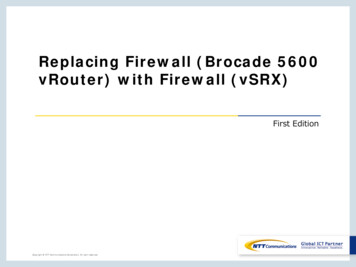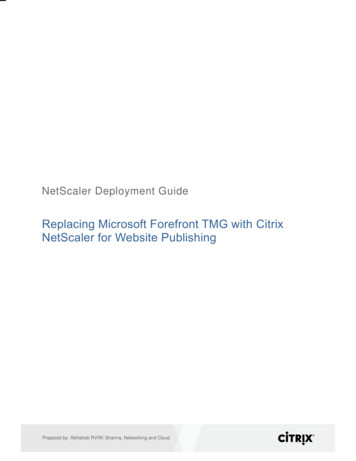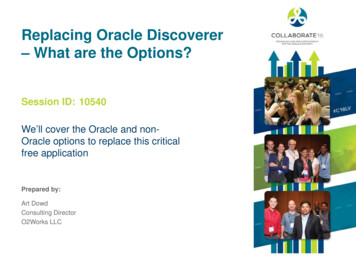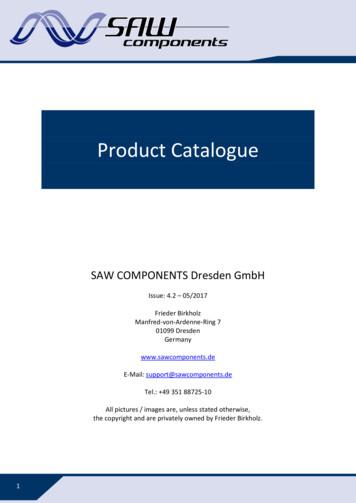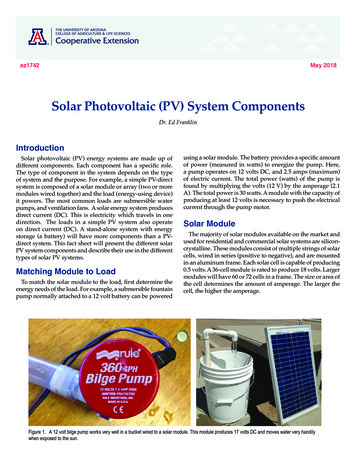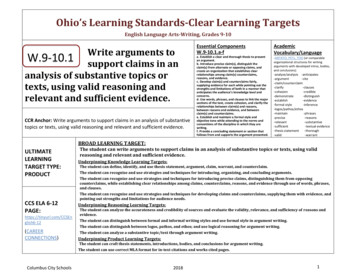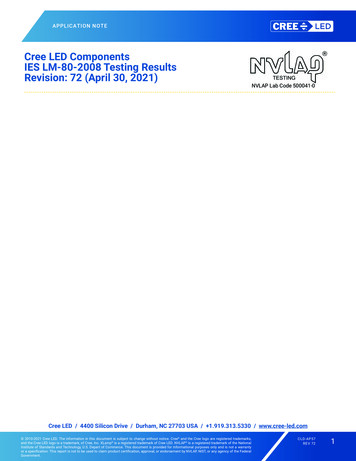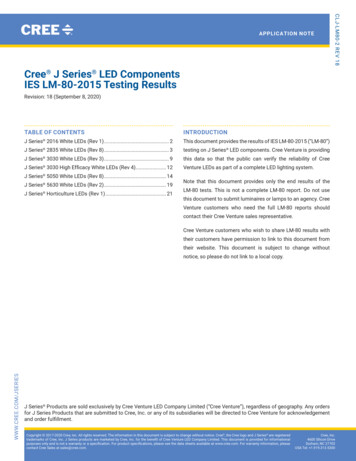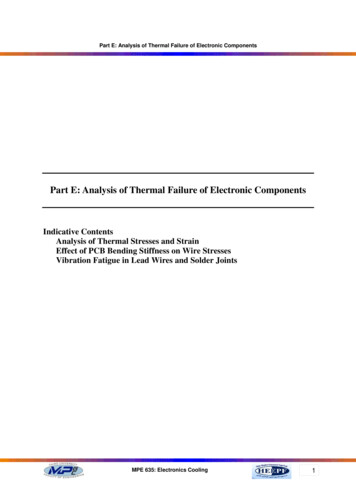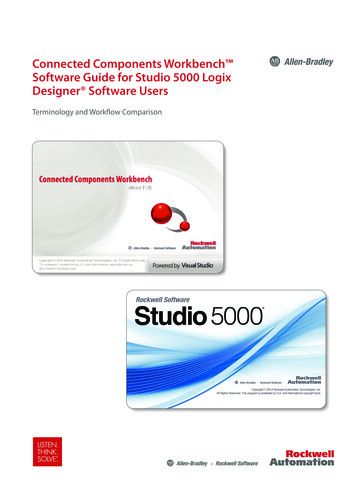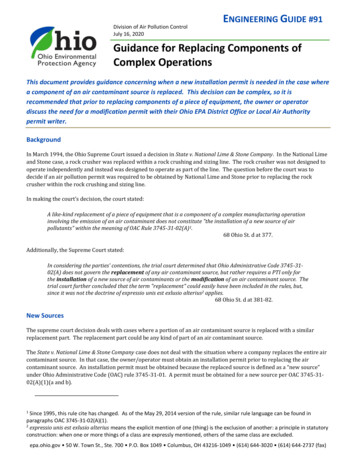
Transcription
Division of Air Pollution ControlJuly 16, 2020ENGINEERING GUIDE #91Guidance for Replacing Components ofComplex OperationsThis document provides guidance concerning when a new installation permit is needed in the case wherea component of an air contaminant source is replaced. This decision can be complex, so it isrecommended that prior to replacing components of a piece of equipment, the owner or operatordiscuss the need for a modification permit with their Ohio EPA District Office or Local Air Authoritypermit writer.BackgroundIn March 1994, the Ohio Supreme Court issued a decision in State v. National Lime & Stone Company. In the National Limeand Stone case, a rock crusher was replaced within a rock crushing and sizing line. The rock crusher was not designed tooperate independently and instead was designed to operate as part of the line. The question before the court was todecide if an air pollution permit was required to be obtained by National Lime and Stone prior to replacing the rockcrusher within the rock crushing and sizing line.In making the court’s decision, the court stated:A like-kind replacement of a piece of equipment that is a component of a complex manufacturing operationinvolving the emission of an air contaminant does not constitute "the installation of a new source of airpollutants" within the meaning of OAC Rule 3745-31-02(A)1.68 Ohio St. d at 377.Additionally, the Supreme Court stated:In considering the parties' contentions, the trial court determined that Ohio Administrative Code 3745-3102(A) does not govern the replacement of any air contaminant source, but rather requires a PTI only forthe installation of a new source of air contaminants or the modification of an air contaminant source. Thetrial court further concluded that the term "replacement" could easily have been included in the rules, but,since it was not the doctrine of expressio unis est exlusio alterius2 applies.68 Ohio St. d at 381-82.New SourcesThe supreme court decision deals with cases where a portion of an air contaminant source is replaced with a similarreplacement part. The replacement part could be any kind of part of an air contaminant source.The State v. National Lime & Stone Company case does not deal with the situation where a company replaces the entire aircontaminant source. In that case, the owner/operator must obtain an installation permit prior to replacing the aircontaminant source. An installation permit must be obtained because the replaced source is defined as a “new source”under Ohio Administrative Code (OAC) rule 3745-31-01. A permit must be obtained for a new source per OAC 3745-3102(A)(1)(a and b).1Since 1995, this rule cite has changed. As of the May 29, 2014 version of the rule, similar rule language can be found inparagraphs OAC 3745-31-02(A)(1).2expressio unis est exlusio alterius means the explicit mention of one (thing) is the exclusion of another: a principle in statutoryconstruction: when one or more things of a class are expressly mentioned, others of the same class are excluded.epa.ohio.gov 50 W. Town St., Ste. 700 P.O. Box 1049 Columbus, OH 43216-1049 (614) 644-3020 (614) 644-2737 (fax)
Guidance for Replacing Components of Complex OperationsModified SourcesIn the case where a portion of an air contaminant source is being replaced, permit writers need to evaluate if the changequalifies as a “modification” as defined in OAC paragraph 3745-31-01(SSS). If it is, then the owner/operator must applyfor and obtain a Chapter 31 modification permit.The modification definition can be tripped in several ways but they all must involve some kind of “physical change orchange in the method of operation.” Ohio EPA considers replacing a part of an air contaminant source to qualify as a“physical change,” however, in most like-kind replacements, there is no increase in the emission rate, increase in ambientimpact or other change that would qualify as a modification. Most like-kind replacements would not trip the modifydefinition and, therefore, would not trip the need to obtain a permit to modify the existing permit.Note that under OAC 3745-31-01(SSS)(1)(a) and (b), there are a number of events or situations that could cause thechange to trip the modify definition. The definition includes events that either are considered modifications or events thatare excluded as being modifications. Events that typically trip the modify definition include events that increase allowableemissions, emit a pollutant not emitted before, relocation of the source to another facility, and/or tripping one of thevarious federal rule modification definitions.Like-Kind EquipmentThe definition of “like-kind” is not found in Ohio EPA rules. When it comes to replacing a portion of an air contaminantsource, Ohio EPA considers the replacement part to be like-kind if the part: Performs the same function as the replaced part.Operates in the same manner as the replaced part.Operates at or near the same speed as the replace part.Does not change the method of operation of the air contaminant source.Some examples of like-kind parts include the following: Replace a ¼ HP motor with another ¼ HP motorReplace a 400 ton/hr. conveyor with another 400 ton/hr. conveyorReplace a print head of a printer with the same size/type print headReplace an oven contained within a printing line with another similar sized and type ovenReplacing a rock crusher with a similar sized rock crusher within a rock crushing and sizing lineWhat happens if the replaced part is not exactly equivalent?In some cases, the replaced part may not be exactly equivalent to the original part. This can happen simply due to the lackof availability of identical replacement parts or due to improved efficiency of replacement parts. How should permitwriters determine if the replaced part is like-kind?Generally, minor increases or decreases in production rate of the replaced equipment would still be considered like-kind.However, the main determination as to whether or not a permit is needed is if the modify definition is tripped, e.g., resultsin an increase in the allowable emissions or an increase in emissions of greater than the de minimis levels of any type ofair contaminant not previously emitted. So, if the replaced part has a higher or lower production rate but the change didnot trip the modify definition, then no permit is needed.Note that when it is decided that the change qualifies as a like-kind change, you still need to look closely at the permit andthe underlying calculations to see if they need updated. At the minimum, you will need to review: Emissions calculation to verify the PTEs; The applicable rules to verify that the same rules apply or to check to see if a new rule applies;Page 2
Guidance for Replacing Components of Complex Operations Compliance determination methods. Was the compliance determination method based on the old productionrate?; and BAT limits. Some BAT limits are based on the production rate. If it changes, then BAT may need to be adjusted.This issue can get complex so permit writers should discuss any concerns with their central office contact.ExamplesThe following are examples of replacement situations and how they would be evaluated.a.Printing lines typically consist of one or more print stations. Each print station cannot operate on its own - itneeds the rest of the line (paper unrolling, paper cutting, ovens, paper rolling, etc.) in order to operate. In thiscase, the replacement of a printing station, if it meets the additional tests listed in the modify rule (not a majormodification, no new emissions, no increase in emissions, etc.), would not need a modification permit and wouldbe considered a like-kind replacement project.b.In the National Lime and Stone case, a rock crusher was replaced in a rock crushing and sizing line. The rockcrusher was designed as part of the complex operation - the crushing and sizing line. The rock crusher was notdesigned to operate independently and instead was designed to operate as part of the line. The court decidedthat this was part of a complex operation which was a replacement and, because it did not trip any other criteriain the modify definition, did not need a modification permit.c.Take the case of a coal-fired boiler which provides process steam to a manufacturing operation. Boilers in thiscase typically operate independently (they often start-up prior to any manufacturing and shutdown beforemanufacturing is complete). If a company wants to replace this type of boiler, because it is an independentoperation, considered a separate air contaminant source, and the replacement of an entire air contaminant sourceis defined as a new source under OAC 3745-31-01, they must obtain an installation permit to install the newboiler.d.Take the example of a burner in a bake-off oven. A bake-off oven typically has multiple burners, conveyingequipment, and exhaust equipment. The burner would be considered a piece of equipment in a complexmanufacturing operation (the air contaminant source). The burner would not operate independently of the oven.If the company wants to replace the burner and it doesn’t trip the additional modification criteria, then nomodification permit is required, and the project would be considered a like-kind replacement.e.Company V, Inc. operates a widget operation which is regulated under OAC rule 3745-17-11. This process has aprocess weight rate of 60 pounds per hour. The company proposes to replace a part of the widget operation (acomplex operation) which results in a new process weight rate of 62 pounds per hour (a minor increase). Theallowable emissions are based on Table I of rule 3745-17-11. Using this table, the original emissions limitation is0.551 pounds per hour. This limit is established in their permit. At 62 pounds per hour process weight rate theemissions limitation based on Table I is also the same - 0.551 pounds per hour. In this case no modificationpermit is needed as long as it does not trip any other modification criteria.f.Company W operates an incinerator. The company determines that the stack on the incinerator is deterioratingand is in danger of failing. In order to reduce costs, the company proposes to replace the existing 100-foot stackwith a 50-foot stack. After the change, the emission rates and emissions limitations will remain the same.This scenario needs to be evaluated under the modify definition. Under the first part of the definition, Ohio EPAwould consider the replacement of the stack to be a “physical change” of the air contaminant source. Afterreviewing paragraph 3745-31-01(SSS)(1)(a) (increase in emissions limitations, moving the air contaminantsource, new pollutant, etc.), none of those apply.Page 3
Guidance for Replacing Components of Complex OperationsThe second part of the modify definition concerns situations where the ambient impact increases due to thechange in the air contaminant source. The incinerator is considered to be a “significant air contaminant source”because the emission of nitrogen oxide is greater than 100 tons/year. Therefore, modeling was completed to seewhat the increase in NOX downwind concentrations would be due to the shorter stack. This analysis shows thatthe increase in ambient concentration was greater than 14 µg/m3 on an annual average.Since the modeling portion of the modify definition was tripped, a modification permit must be obtained beforethe change is approved.In this case, there are really two reasons why the stack replacement would not qualify as a like-kind replacementwhich doesn’t require a permit modification. The first reason is that the modify definition is tripped due to theincreased ambient concentration over the thresholds. The second reason is that the replaced stack is not likekind; it is not the same size and type of stack.g.Company X operates a large coal-fired boiler. The boiler is getting on in age and it is determined that it needs acomplete rebuild which involves replacing multiple parts within the boiler with like-kind parts. After the rebuild,the boiler will have the same capacity and operation as originally permitted.The permit writer reviews the project and determines that the rebuild project will result in an increase in theemission rate of NOX to the atmosphere. Therefore, under the NSPS, the project qualifies as a “modification.”Since there is a physical change to the emissions unit and the project is considered a modification under the NSPS,the owner/operator must obtain a modification permit prior to the change because the modification definitionunder 3745-31-01(SSS) is tripped. The project cannot be considered a like-kind project that does not need apermit modification.h.Company Y operates a combustion turbine. The turbine has been operating for many years and some of theinternal parts are showing signs of wear. Based on the turbine manufacturer’s recommendation, Company Ydecides to replace internal parts of the turbine with manufacturer’s recommended replacement parts. The designof the parts has evolved over time and the new parts are slightly more efficient than the old parts so the turbinewill be able to produce slightly more power than originally designed. What should you review to determine if thisproject qualifies as a like-kind replacement? Verify that the parts will perform the same function, in the same manner, and approximately the same speedas the replaced parts.Verify that the replacement does not change the method of operation. For instance, the change should not gofrom a low NOX burner configuration to a water injection configuration.Verify that the change does not qualify as a modification under the rule.Verify that the change is not considered a major modification under the rules. For instance, you might needto perform a (baseline) actuals to projected actuals applicability test.If the project is not considered a major modification nor a modification, then it can be considered like-kind.i.Company Z operates a compressor station. The compressor station contains several emissions units that includea compressor engine and a compressor. For each of these, the compressor engine and the compressor mustoperate in concert and so the combination of these two pieces of equipment constitutes one emissions unit and isconsidered a complex manufacturing operation.The engine is wearing out and needs to be replaced. Company Z purchases a same size and type of engine. Canthis be a like-kind replacement?In many cases, the answer will be yes. However, you still need to check to see if either the major modification ormodification definitions apply. If either of these do apply, then a permit is required before the change can bePage 4
Guidance for Replacing Components of Complex Operationsimplemented. If the replacement is considered a modification under either the NSPS or NESHAPS, or isconsidered either a new source or reconstruction under a MACT, then the replacement is considered amodification under Ohio rules and a permit will be required.There can also be other situations where administrative changes to the permit are needed to use the replacedengine. Each situation can be different and will need to be evaluated closely.Because these issues can get complex, it is recommended that permit writers and inspectors discuss any questions orconcerns with their central office contact.Clarification on Some Defined TermsOhio Administrative Code (OAC) Chapter 31 contains some terms that are possibly confusing when it comes to like-kindreplacement. First, the term like-kind replacement is not defined in the rule, so the only direct guidance concerning thisterm is found in this Engineering Guide. Second, OAC rule 3745-31-01 contains a definition of “Replacement Unit” whichsome have used to justify not getting a permit when they replace a source.The “replacement unit” term is used to support major NSR determinations and is not designed or used to support likekind replacement decisions. It is used in two locations in Chapter 31. The first is as part of the definition of “net emissionsincrease” where it is used to discuss shakedown periods. The second is part of the definition of “emissions unit” whichincludes a sub definition of “existing emissions unit.” The “existing emissions unit” term is used throughout the rules tosupport major NSR determinations.RevisionsThis guidance was originally issued as a draft in March 1995.ContactFor more information, contact Michael Hopkins at michael.hopkins@epa.ohio.gov or (614) 644-2270.MH/\EG#91Guidance Replacing Equipment Final20200716.docxPage 5
Replace a 400 ton/hr. conveyor with another 400 ton/hr. conveyor . writers determine if the replaced part is like-kind? . The applicable rules to verify that the same rules apply or to check to see if a new rule applies; Guidance for R

